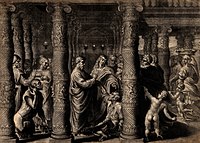John Simon (engraver)
John Simon | |
|---|---|
| Born | Jean Simon c. 1675 |
| Died | September 22, 1751 (aged 75–76) |
| Nationality | |
| Known for | Mezzotint prints |
Jean Simon, anglicized as John Simon (also spelled Simons;[a] c. 1675–1751) was an English mezzotint engraver and print publisher of French Huguenot birth, particularly known for his portraits. Notably associated with the portrait painter Godfrey Kneller, Simon had an active career that spanned at least three and a half decades, and was regarded as one of the mezzotint medium's most prolific masters of his generation, along with the older contemporaneous engraver John Smith.[4]
Life[]
Born Jean Simon c. 1675 in Normandy,[5] he was said to belong to a Huguenot artist family that was connected to the protestant church at Charenton-le-Pont near Paris. In Paris, he studied line engraving.[6] Early in the 18th century,[b] Simon moved to London and began working in mezzotint, quickly adapting to the market demands;[8] his earliest known prints were published from Cross Lane, Long Acre, during the middle years of Queen Anne's reign.[11] In c. 1708–1709, Simon gained the attention of Godfrey Kneller, who fell out with his principal engraver, John Smith. Until the dispute with Smith was settled, Simon obtained several of Kneller's commissions.[12] This assured Simon's reputation, allowing him to become a founding member of the Academy for Artists in Great Queen Street, set up under Kneller's patronage in 1711.[13] In his notebooks, George Vertue listed Simon among leading mezzotint engravers working in London, along with Smith, John Faber Sr., John Faber Jr., and George White;[14] from Vertue's notebooks, it is also known that Simon was an associate of the renowned Rose and Crown Club.[15]
From early in his career, Simon began working extensively for the prominent print seller Edward Cooper (fl. 1682–1725); particularly noted was a c. 1707 publication by Cooper of a set of mezzotints made by Simon after the Raphael Cartoons in Hampton Court Palace, devoted to the 2nd Duke of Devonshire.[16] After Cooper's death in 1725, Simon succeeded him as chief publisher of Michael Dahl's paintings.[17] Beside from Cooper, Simon was employed by such notable publishers as Thomas Bowles II (c. 1689–1767) and John Overton (c. 1639–1713); since c. 1720, he mostly published his own prints from a series of addresses around Covent Garden. After at least three and a half decades,[18] Simon retired from active printmaking c. 1742, nine year before his death on 22 September 1751;[c] his remaining stock of plates was sold in November 1761.[21]
Work[]
Simon was a prolific printmaker,[d] particularly noted for portraits made after Kneller, Dahl, Thomas Gibson, Thomas Murray, Philippe Mercier, Enoch Seeman, and others.[25] Subjects of Simon's portraits represented all points of the political spectrum, including the Duke of Marlbourough, Robert Walpole, Francis Atterbury, Lord North and Grey, the 10th Earl Marischal, and the Duke of Ormond; similarly, portraits of members of the then reigning House of Hanover were balanced by those of exiled members of the House of Stuart. Simon also engraved sets of the Four Mohawk Kings after John Verelst, published in 1710,[26] and of twenty-four Poets and Philosophers of England published on six plates c. 1727.[27][28] Beside from portraiture, Simon took biblical, historical, and decorative subjects; beside from the Raphael Cartoons, these include Christ Restoring the Blind Man's Sight by Louis Laguerre, Four Elements by Jacopo Amigoni, Four Seasons by Rosalba Carriera; he was also known to make prints after Antoine Watteau,[29] Jean-Baptiste-Siméon Chardin,[30] Peter Paul Rubens, Federico Barocci, Sébastien Leclerc, and others.[31]
According to later authors, Simon had a "spare and powerful"[32] style influenced by that of Smith, yet contrasting with the latter, including cases the both worked after the same original;[33] in comparison to Smith, Simon was known to use a less close grounding of plates, with laying small cross-hatched lines;[34] In that relation, Simon's skill was regarded as inferior to Smith's in technical terms such as brilliance effect, drawing of the figures and details; nonetheless, Simon closely rivaled Smith in his finest works.[35] In spite of aforementioned issues, Simon's prnts were esteemed among "the most successful mezzotints of their day";[36] in the 20th century, the English authors Malcolm Charles Salaman and the 3rd Baron Killanin credited Simon for bringing a French influence and a "fresh artistic sensitiveness" into the mezzotint medium.[37] Peter Pelham, notable American painter and mezzotint engraver, was an apprentice of Simon in London.[38][39]
Gallery[]

Henri de Massue, Earl of Galway, after Philip de Graves, National Gallery of Ireland, Dublin[40]
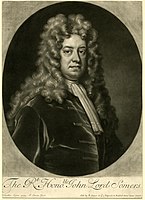
John Somers, 1st Baron Somers, after Godfrey Kneller, British Museum, London[41]
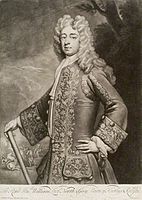
William North, 6th Baron North, after Godfrey Kneller, National Portrait Gallery, London[42]

Charles Wills, after Michael Dahl, National Portrait Gallery, London[43]

Queen Anne, after Edmund Lilly, British Museum, London[44]
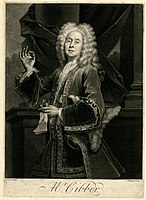
Colley Cibber, after Giuseppe Grisoni, British Museum, London[45]

Thomas Britton, after John Wollaston I, British Museum, London[46]
Mary Montagu, Duchess of Montagu, after Charles d'Agar, National Portrait Gallery, London[42]

Sir Théodore Turquet de Mayerne, after Peter Paul Rubens, Wellcome Collection, London[47]

Etow Oh Koam, King of the River Nation, plate from the Four Mohawk Kings set, after John Verelst, National Portrait Gallery, London
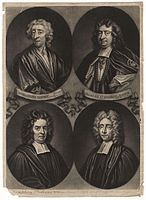
Gilbert Burnet, John Locke, Humphrey Prideaux, and Samuel Clarke, plate from the Poets and Philosophers of England set, National Portrait Gallery, London

A Winter Evening's Conversation, National Portrait Gallery, London

Masquerade, after Antoine Watteau, Yale Center for British Art, New Haven, Connecticut[8]
Notes[]
- ^ Chelsum 1786, p. 88, uses the spelling Simons, and so do the 1826 and 1849 editions of George Vertue's A Catalogue of Engravers, published as part of Horace Walpole's Anecdotes of Painting in England;[1][2] the original 1765 edition of Vertue's Catalogue, as well as the subsequent 1879 edition of Walpole's Anecdotes, use the spelling Simon.[3]
- ^ Exact time of Simon's moving to England remains imprecise. Following Vertue's account published by Walpole, 18th- and 19th-century authors wrote that Simon settled in London "some years" before the death of Smith. In later publications, a variety of differently specified datings is given.[7] In 1990, Carol Wax attributed Simon's arrival to 1708.[8]
In light of Simon's Huguenot background, it has been widely thought that his moving was related to persecutions that followed the Edict of Fontainebleau of 1685.[9] In a different opinion, the Hungarian-born scholar Frederick Antal names Simon among French-born printmakers brought in England by Claude Du Bosc.[10] - ^ Various publications, ranging from the late 18th century to the late 20th century, date Simon's death c. 1755.[19] In the Benezit Dictionary of Artists, Simon's death is dated 1754.[20]
- ^ In the middle 19th century, the French librarian Charles Le Blanc (1817–1865) catalogued 195 prints made by Simon;[22] later in that century, the Irish mezzotint amateur John Chaloner Smith described 177 mezzotints by Simon.[23] Various 20th-century sources estimate about 200 prints made by Simon.[24]
References[]
- ^ Walpole, Horace (1826). Anecdotes Of Painting In England. 5. London: Shakspeare Press. pp. 179, 183, 260. OCLC 1039493204 – via the Internet Archive.
- ^ Walpole, Horace (1849). Anecdotes of Painting in England. 3. London: H. G. Bohn. pp. 934, 936, 978 – via the Internet Archive.
- ^ Vertue 1765, p. 133; Walpole 1879, p. 463.
- ^ Vertue 1932, p. 11; Allison 1947, p. 441; Whinney & Millar 1957, p. 12; Wilder 1969, pp. 124, 128; Oliver 1973, p. 174; Saunders 1995, p. 45.
- ^ Killanin 1948, p. 58, names Charenton-le-Pont as Simon's birthplace.
- ^ Smith 1878–1884, pt. 3, pp. 1060–1061; Sharp 2004, p. 659.
- ^ Whitman 1898, p. 23, says that Simon came to London "in the early years of the century". Davenport 1904, p. 112, Vollmer 1937, p. 56, and Myers 1969, p. 182, date the arrival "about the beginning of the eighteenth century," whereas Hind 1963, p. 271, writes of "the first half of the eighteenth century."
- ^ Jump up to: a b c Wax 1990, p. 28.
- ^ Redgrave 1878, p. 395; Smith 1878–1884, pt. 3, pp. 1060–1061; O'Donoghue 1897, p. 265; Whitman 1898, p. 23; Davenport 1904, p. 112; Salaman 1910, p. 14; Vollmer 1937; Killanin 1948, p. 58; Wax 1990, p. 28; Joubert 2002, p. 68.
- ^ Antal 1962, p. 151.
- ^ Smith 1878–1884, pt. 3, p. 1061; O'Donoghue 1897, p. 265; Salaman 1910, p. 14; Sharp 2004, pp. 659–660.
- ^ Vertue 1934, p. 14; Godfrey 1978, p. 29; Wax 1990, p. 28; Griffiths 1996, p. 85; Clayton 1997, p. 59.
- ^ Vertue 1952, p. 168, cited in Bignamini 1988, pp. 76, 81 n. 74; Clayton 1997, pp. 13, 59; Sharp 2004, p. 660.
- ^ Vertue 1932, p. 11; Vertue 1934, p. 8, cited in Burke 1976, p. 178; Atherton 1974, p. 44.
- ^ Vertue 1952, p. 35, cited in Bignamini 1988, pp. 55, 60 n. 67.
- ^ Clayton 1997, pp. 49–50; Sharp 2004, p. 660; Hsien 2009, p. 907.
- ^ Clayton 1997, pp. 20–21.
- ^ Salaman 1910, p. 14 and Gohm 1978, p. 38, estimate Simon's active career as 35 years, from 1707 to 1742.
- ^ Vertue 1765, p. 133; Strutt 1785–1786, p. 321; Chelsum 1786, p. 88; Le Blanc 1854–1890, p. 517; Redgrave 1878, p. 395; Walpole 1879, p. 463; Smith 1878–1884, pt. 3, p. 1061; Portalis & Béraldi 1882, p. 548; Bryan 1905, p. 84; Dacier & Vuaflart 1922, pp. 23, 134; Herold & Vuaflart 1929, pp. 91, 261; Dukelskaya 1987, p. 36; Saunders 1995, p. 45.
- ^ Bénézit 2006, p. 1234.
- ^ O'Donoghue 1897, p. 265; Vertue 1934, p. 158; Sharp 2004, p. 660.
- ^ Le Blanc 1854–1890, pp. 517–521, cited in Demkin 2009, p. 36.
- ^ Smith 1878–1884, pt. 3, pp. 1060–1130, cited in Dukelskaya 1987, p. 36.
- ^ Salaman 1906, p. 82; Vollmer 1937, p. 56; Myers 1969, p. 182; Gohm 1978, p. 38.
- ^ Redgrave 1878, p. 395; Hind 1963, p. 271; Dukelskaya 1987, p. 36; Sharp 2004, p. 660.
- ^ Muller 2008, pp. 28, 42.
- ^ Clayton 1997, p. 62.
- ^ O'Donoghue 1897, p. 265; Sharp 2004, p. 660.
- ^ Le Blanc 1854–1890, vol. 3, p. 521; Dacier & Vuaflart 1922, pp. 23, 134; Herold & Vuaflart 1929, pp. 91, 260–262; Antal 1962, p. 35; Roland Michel 1986, p. 55.
- ^ Jourbert 2002, p. 68.
- ^ Bryan 1903–1905, p. 84; Davenport 1904, p. 113; Salaman 1906, p. 87; Salaman 1910, p. 14; Vollmer 1937, p. 56.
- ^ Sharp 2004, p. 660.
- ^ Smith 1878–1884, pt. 3, p. 1061; Whitman 1898, p. 23; Killanin 1948, p. 58; Hind 1963, p. 381.
- ^ Davenport 1904, p. 112; Arms 1934, p. 110; Killanin 1948, p. 58.
- ^ Chelsum 1786, p. 88; Walpole 1879, p. 463; Smith 1878–1884, pt. 3, p. 1061; Whitman 1898, p. 23; Davenport 1904, p. 112; Salaman 1910, p. 14; Sharp 2004, p. 660.
- ^ Arms 1934, p. 110.
- ^ Salaman 1910, p. 14; Killanin 1948, p. 58.
- ^ Allison 1947, p. 441; Oliver 1973, p. 174; Wax 1990, p. 91; Saunders 1995, p. 45.
- ^ Barhill, Georgia Bardy (1996). "Pelham, Peter". In Turner, Jane (ed.). The Dictionary of Art. 24. New York: Grove's Dictionaries. p. 335. ISBN 1-884446-00-0. OCLC 1033638207 – via the Internet Archive.
- ^ Jump up to: a b c Chelsum 1786, p. 88; Walpole 1879, p. 463.
- ^ Salaman 1910, p. 15; Hind 1963, p. 271.
- ^ Jump up to: a b Salaman 1910, p. 15.
- ^ Hind 1963, p. 271.
- ^ Jeffree, Richard (1996). "Lilly, Edmund". In Turner, Jane (ed.). The Dictionary of Art. 19. New York: Grove's Dictionaries. p. 384. ISBN 1-884446-00-0. OCLC 1033643331 – via the Internet Archive.
- ^ Whitman 1898, pp. 23–24; Salaman 1906, p. 82; Salaman 1910, p. 14
- ^ Salaman 1906, p. 83; Salaman 1910, p. 15.
- ^ Chelsum 1786, p. 88.
- ^ Rovinsky 1887, col. 1272; Demkin 2009, p. 36.
- ^ Hermitage Museum, Saint Petersburg (2001). Эрмитаж. Музей и коллекции (exhibition catalogue). Saint Petersburg: Slavia. p. 203. ISBN 5-88654-159-4. OCLC 57350723.
Sources[]
- Allison, Anne (December 1947). "Peter Pelham, Engraver in Mezzotinto". Antiques. 52: 441–443.
- Antal, Frederick (1962). Hogarth and His Place in European Art. New York: Basic Books. pp. 35, 151. OCLC 1035595582 – via the Internet Archive.
- Arms, John Taylor (1934). Handbook of Print Making and Print Makers. New York: Macmillan. p. 110. OCLC 609230931 – via Google Books.
- Atherton, Herbert M. (1974). Political Prints in the Age of Hogarth: A Study of the Ideographic Representation of Politics. Oxford: Clarendon Press. p. 44. ISBN 0-19-827188-3. OCLC 1034667797 – via the Internet Archive.
- Bénézit, Emmanuel (2006) [first published in French in 1911–1923]. Benezit Dictionary of Artists. 12. Paris: Gründ. pp. 1234. ISBN 2-7000-3082-6 – via the Internet Archive.
- Bignamini, Ilaria (1988). "George Vertue, Art Historian and Art Institutions in London, 1689–1768: A Study of Clubs and Academies". The Walpole Society. 54: 1–148. JSTOR 41829562.
- Bryan, Michael (1903–1905). Bryan's Dictionary of Painters and Engravers. 5. New York: Macmillan. pp. 83–84. OCLC 1041637252 – via the Internet Archive.
- Burke, Joseph (1976). English Art, 1714–1800. Oxford History of English Art. 9. Oxford: Clarendon Press. p. 178. ISBN 0-19-817209-5. OCLC 1150946106 – via the Internet Archive.
- Chelsum, James (1786). A History of the Art of Engraving in Mezzotinto. Winchester: J. Robbins. p. 88. OCLC 1157144486 – via the Internet Archive.
- Clayton, Muriel (1930). The Print Collector. New York: Dodd, Mead, and Co. p. 124. OCLC 1151061238 – via the Internet Archive.
- Clayton, Timothy (1997). The English Print, 1688–1802. London, New Haven: Yale University Press. ISBN 0-300-06650-3.
- Dacier, Émile; Vuaflart, Albert (1922). Jean de Julienne et les graveurs de Watteau au XVIII-e siècle. III. Catalogue (in French). Paris: M. Rousseau. pp. 23, 134. OCLC 1039156495.
- Davenport, Cyril (1904). Mezzotints. London: Methuen and Co. pp. 104, 112–113, 115. OCLC 1049687052 – via the Internet Archive.
- Demkin, A. D. (2009). "Малоизвестные портреты А. Д. Меншикова и членов его семьи". История Петербурга (in Russian). No. 51. pp. 33–44. Retrieved 25 July 2021.
- Dukelskaya, L. A. (1987). Английское меццо-тинто конца XVII—XVIII века из собрания Эрмитажа (exhibition catalogue) (in Russian). Leningrad: Iskusstvo. p. 36. OCLC 702704438.
- Godfrey, Richard T. (1978). Printmaking in Britain: A General History from Its Beginnings to the Present Day. New York: New York University Press. p. 29. ISBN 0-8147-2973-8. OCLC 1151065422 – via the Internet Archive.
- Gohm, Douglas Charles (1978). Maps and Prints for Pleasure and Investment. London: Gifford. p. 38. ISBN 0-7071-0567-6. OCLC 1245546044 – via the Internet Archive.
- Griffiths, Anthony (1996). Prints and Printmaking: an Introduction to the History and Techniques. Berkeley, Los Angeles: University of California Press. p. 85. ISBN 0-520-20714-9. OCLC 1036831840 – via the Internet Archive.
- Herold, Jacques; Vuaflart, Albert (1929). Jean de Julienne et les graveurs de Watteau au XVIII-e siècle. I. Notices et documents biographiques (in French). Paris: M. Rousseau. pp. 91, 260–262. OCLC 1039157338.
- Hind, Arthur M. (1963). A History of Engraving & Etching from the 15th Century to the Year 1914 (3rd, fully rev. ed.). New York: Dover. pp. 271, 373, 381. OCLC 1035610203 – via the Internet Archive.
- Hsieh, Chia-Chuan (December 2009). "Publishing the Raphael Cartoons and the Rise of Art-Historical Consciousness in England, 1707–1764". The Historical Journal. 52 (4): 899–920. JSTOR 25643863.
- Joubert, Caroline (2002). Ars nigra: la gravure en manière noire aux XVIIe et XVIIIe siècles (exhibition catalogue) (in French). Paris, Caen: Somogy, Musée des Beaux-Arts. p. 68. ISBN 2-85056-596-2. OCLC 1119482569.
- Killanin, Michael Morris, Baron (1948). Sir Godfrey Kneller and His Times, 1646-1723. London: Batsford. p. 58. OCLC 1263366 – via Google Books.
- Le Blanc, Charles (1854–1890). Manuel de l'amateur d'estampes (in French). 3. Paris: E. Bouillon. pp. 517–521. OCLC 793563927 – via the Internet Archive.
- Myers, Bernard S., ed. (1969). "Simon, John (Jean)". McGraw-Hill Dictionary of Art. 5. New York: McGraw-Hill. p. 182. OCLC 1150312272 – via the Internet Archive.
- Muller, Kevin R. (Fall 2008). "From Palace to Longhouse: Portraits of the Four Indian Kings in a Transatlantic Context". American Art. 22 (3): 26–49. doi:10.1086/595806. JSTOR 10.1086/595806. S2CID 159984142.
- (1897). . In Lee, Sidney (ed.). Dictionary of National Biography. 52. London: Smith, Elder & Co. p. 265.
- Oliver, Andrew (1973). "Peter Pelham (c. 1697–1751), Sometimes Printmaker in Boston". In Colonial Society of Massachusetts, Boston (ed.). Boston Prints and Printmakers, 1670-1775 (conference papers). Publications of the Colonial Society of Massachusetts. 46. Boston, Charlottesville: Colonial Society of Massachusetts, University Press of Virginia. pp. 133–173. OCLC 1028858792 – via the Internet Archive.
- Portalis, Roger; Béraldi, Henri (1882). "Les Simon". Les graveurs du dix-huitième siècle [Engravers of the Eighteenth Century] (in French). 3 (pt. 2). Paris: D. Morgand et C. Fatout. p. 548. OCLC 1050245691 – via the Internet Archive.
- Redgrave, Samuel (1878). A Dictionary of Artists of the English School (2nd ed.). London: George Bell. p. 395. OCLC 1043009709 – via the Internet Archive.
- Roland Michel, Marianne (1986). "Watteau and England". In Hind, Charles (ed.). The Rococo in England. London: Victoria and Albert Museum. pp. 46–59. ISBN 0-948107-37-5. OCLC 18588917.
- Rovinsky, D. A. (1887). Подробный словарь русских гравированных портретов (in Russian). 2. Saint Petersburg: Imperial Academy of Sciences.
- Salaman, Malcolm C. (1906). The Old Engravers of England in Their Relation to Contemporary Life and Art (1540-1800). London et al.: Cassell and Co. pp. 81–87, 97, 177. OCLC 1049965266 – via the Internet Archive.
- Salaman, Malcolm C. (1910). Holme, Charles (ed.). Old English Mezzotints. London et al.: The Studio. pp. 14–15. OCLC 1049974212 – via the Internet Archive.
- Saunders, Richard H. (1995). John Smibert: Colonial America's First Portrait Painter. New Haven, London: Yale University Press. p. 45. ISBN 0-300-04258-2. OCLC 31607421.
- Sharp, Richard (2004). "Simon, John". In Matthew, H. C. G. & Harrison, Brian (eds.). Oxford Dictionary of National Biography. 50. Oxford, New York: Oxford University Press. pp. 659–660. ISBN 0-19-861400-4. OCLC 1035757202 – via the Internet Archive. Also available via Oxford DNB Online (subscription or UK public library membership required).CS1 maint: postscript (link)
- Smith, John Chaloner (1878–1884). British Mezzotinto Portraits. London: H. Sotheran. pt. 3, pp. 1060–1130; pt. 4, div. 2, p. 1861–1863. OCLC 679810041 – via the Internet Archive.
- Strutt, Joseph (1785–1786). "John Simon". A Biographical Dictionary Containing All the Engravers, From the Earliest Period of the Art of Engraving to the Present Day. 2. London: Robert Faulder. p. 321. OCLC 1045222436 – via the Internet Archive.
- Vertue, George (1765). Walpole, Horace (ed.). A Catalogue of Engravers. Strawberry Hill: Thomas Kirgate. p. 133. OCLC 1039533429 – via the Internet Archive.
- Vertue, George (1932). "The Note-Books of George Vertue Relating to Artists and Collections in England (II)". The Walpole Society. 20. whole issue. JSTOR i40086519.
- Vertue, George (1934). "The Note-Books of George Vertue Relating to Artists and Collections in England (III)". The Walpole Society. 22. whole issue. JSTOR i40086509.
- Vertue, George (1952). "The Note-Books of George Vertue Relating to Artists and Collections in England (VI)". The Walpole Society. 30. whole issue. JSTOR i40086545.
- Vollmer, Hans, ed. (1937). "Simon (bei Walpole: Simons), Jean (John)". Allgemeines Lexikon der bildenden Künstler (in German). 31. Leipzig: E. A. Seemann. p. 56.
- Walpole, Horace (1879). Anecdotes Of Painting In England. London: Ward, Lock, and Co. p. 463. OCLC 1039484687 – via the Internet Archive.
- Wax, Carol (1990). The Mezzotint: History and Technique. New York: H. N. Abrams. pp. 28, 32, 76, 91. ISBN 0810936038 – via Google Books.
- Whinney, Margaret; Millar, Oliver (1957). English Art, 1625–1714. Oxford History of English Art. 8. Oxford: Clarendon Press. p. 12. OCLC 1150992276 – via the Internet Archive.
- Whitman, Alfred (1898). The Masters of Mezzotint: The Men and Their Work. London: G. Bell and Sons. pp. 22, 23, 25. OCLC 741495781 – via Google Books.
- Wilder, F. L. (1969). How to Identify Prints. London: G. Bell and Sons. pp. 124, 128. OCLC 1244861362 – via the Internet Archive.
| Wikimedia Commons has media related to John Simon. |
- 1675 births
- 1751 deaths
- 17th-century engravers
- 18th-century engravers
- French engravers
- English engravers
- Huguenots














